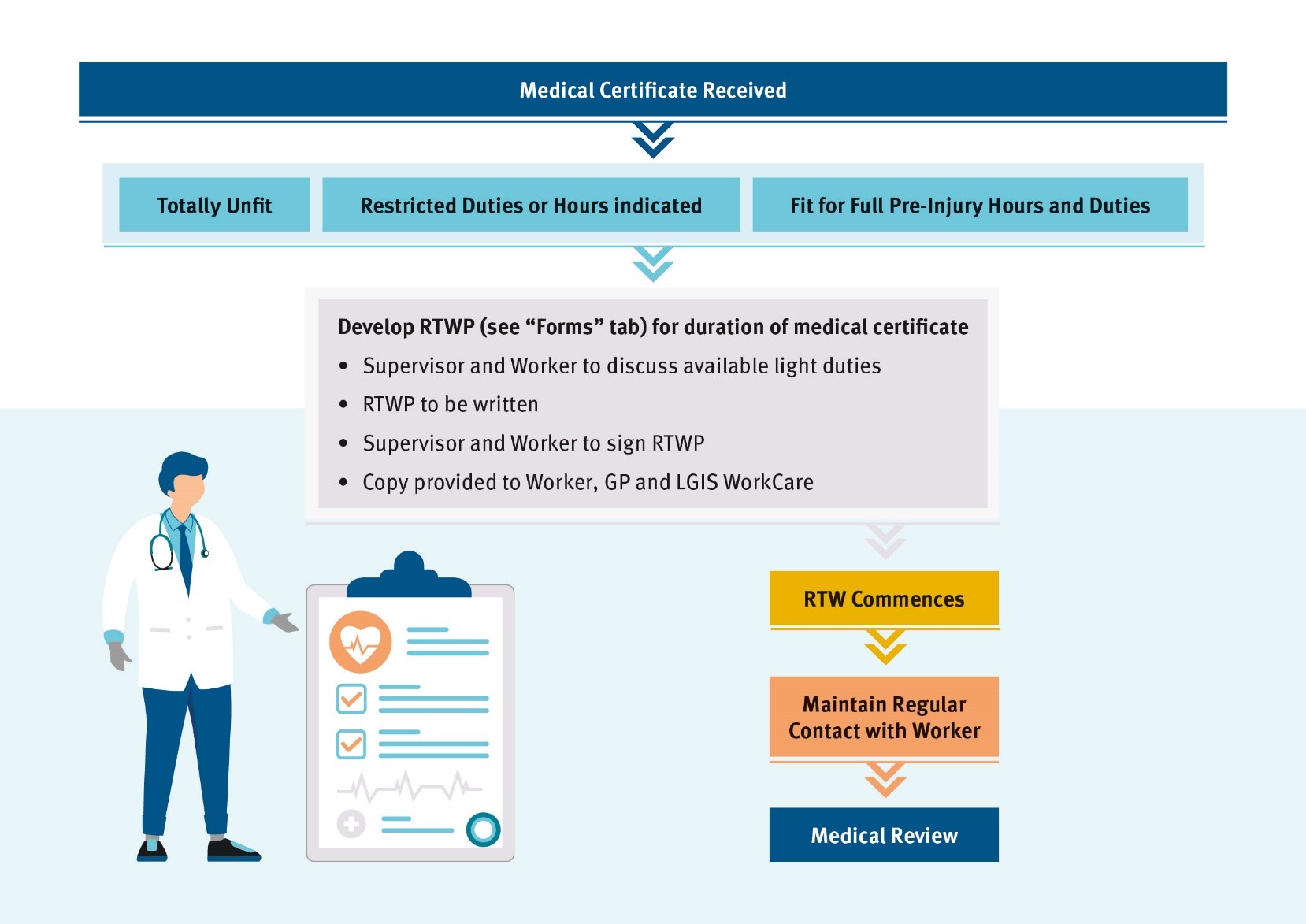
Return to work process
A return to work program is a document that matches the medical restrictions and recommendations made by an injured worker's treating practitioner, with the duties and tasks available in the workplace. In the first instance, the aim of the program is to return the injured worker to their pre-injury hours and duties as quickly and safely as possible
When is a return to work program required?
An employer is responsible for ensuring there is a return-to-work program established as soon as practicable after the earliest of the following:
- The day on which the worker's treating medical practitioner issues a certificate of capacity to the effect that the worker is partially incapacitated for work.
- The day on which the worker's treating medial practitioner advises the employer in writing that a return-to-work program should be established for the worker.
- The day on which an arbitrator determines, or the parties agree, that the worker has suffered an injury in respect of which compensation is payable and is partially incapacitated for work.
If required to establish a return-to-work program for a worker, you the employer, must give the worker an opportunity to participate in its establishment and take reasonable steps to ensure the worker agrees to the content.
WorkCover WA has a mandated return to work form that must be used in all circumstances for any worker under the Workers Compensation and Injury Management Act.
Goal setting
Prior to commencing the return-to-work process, it is essential that a return-to-work goal is established and agreed to by key stakeholders. The return-to-work goal describes what the injured worker will be doing when they have returned to their best possible work capacity and ensures that all key stakeholders are working towards a common aim.
The hierarchy we work towards is as follows:
- Same employer/ same duties
- Same employer/ modified duties
- Same employer / new duties
- New employer/ modified duties
- New employer/ new duties
The RTW goal must be:
- Agreed by the treating doctor, worker and employer
- Included in the RTW Program
- Based on the hierarchy of RTW outcomes
- Changed only on the basis of medical advice and with the consent of key parties

Return to work program must be provided to LGIS within 7 days of being drafted and confirmed by all stakeholders.
Workplace rehabilitation providers
A workplace rehabilitation consultant is an experienced and qualified Allied Health professional who specialises in understanding the complexities of injuries and return to work. They can assist in the following ways:
- They assist in identifying and addressing risk factors that may impact on a worker's successful return to work.
- They assess a workers functional and psychological capacity and provide recommendations to translate functional gains into meaningful work.
- They provide advice on the best pathway to recovery to work.
- They engage with a workers' treating medical practitioner and provide information that will inform treatment plans, certificates of capacity and return to work programs by providing insight into the work environment.
- They make recommendations as to how a worker can be accommodated within the workplace while they recover.
- They can assess and analyse the physical and psychological demands of the work tasks and review how they could be modified for the worker whilst they are under restrictions and determine what duties are safe for them to undertake.
- They provide supportive, educational and motivational rehabilitation counselling to assist a worker to maximise their function and manage their injury throughout the return to work process to help a worker identify their vocational strengths, skills and abilities if they are unable to perform their pre-injury work and assist with identifying steps that can be taken to transition into a different type of work if they are medically unable to return to their pre-injury role.
- If you the employer are uncertain on how to develop a return-to-work plan or there is a complex injury, please contact your Injury Management Advisor or imconsultant@lgiswa.com.au and we will assist by appointing one of our Workplace Rehabilitation Provider Panel. The LGIS Workplace Rehabilitation Panel has been vetted through a highly rigorous tender process in alignment with LGIS and WALGA. They are trained to understand our members needs and support them meeting their legal obligations under the Act.
Return to work employer obligations:
Under the Workers Compenation and Injury Management Act (2023), Part 3 – injury management, an employer is legally required to have an injury management system established and implemented in relation to workers you employ.
You must provide an injured worker with their pre-injury position, if reasonably practicable, or a suitable position comparable in status and pay to the worker's pre-injury position for which they are qualified and capable of performing.
This requirement applies for a 12-month period from the day the worker becomes incapacitated for work as a result of the injury.
There are fines and penalities for employers who do not have an injury management system in place and do not support a worker with their recovery at work.
Resources
- Guide for employers
- Fact sheet: return to work for employers
- Injury management system template
- Return to work programme explanatory notes
If you have any questions, or require support to understand your legal obligations under the Workers Compensation and Injury Management Act (2023) or require assistance with development of a Return to Work Plan, please contact your Injury Management Advisor or alternatively email imconsultant@lgiswa.com.au and one our Injury Management team will be in touch to assist.